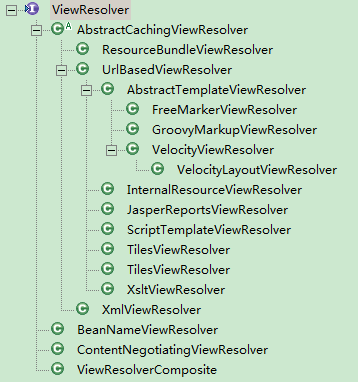13.SpringMVC 檢視解析
基本概念
所有的 MVC 框架都有一套它自己的解析檢視的機制,SpringMVC 也不例外。
它使用 ViewResolver 進行檢視解析,讓使用者在瀏覽器中渲染模型。
ViewResolver 介面在檢視名稱和真正的檢視之間提供對映,它是一種開箱即用的技術,能夠解析 JSP、Velocity 模板和 XSLT 等多種檢視:
檢視解析器在 SpringMVC 中配置如下(以 InternalResourceViewResolver 為例 ):
<bean class="org.springframework.web.servlet.view.InternalResourceViewResolver" bean:表示指定的檢視解析器
viewClass: 表示要解析的檢視型別
prefix/suffix: 表示路徑字首/字尾,假設 ViewName 為 hello,則完整路徑為 /WEB-INF/page/hello.jsp
內部構造
ViewResolver ,即檢視解析器,該介面的主要作用就是根據檢視名 (ViewName),返回檢視 (View)。下面來它的原始碼:
public interface ViewResolver {
View resolveViewName(String viewName, Locale locale) throws Exception;
}再它的繼承關係:
AbstractCachingViewResolver
該類是 ViewResolver 介面的抽象實現類,用來表示一個帶有快取功能的檢視解析器。
下面來看它的 resolveViewName:
// 成員變數
private boolean cacheUnresolved = true;
public View resolveViewName(String viewName, Locale locale) throws Exception {
// 1.判斷快取是否開啟
if (!isCache()) {
// 2.快取關閉,則建立檢視
return createView(viewName, locale);
} else {
// 3.1.快取開啟,從 viewAccessCache 取出檢視
Object cacheKey = getCacheKey(viewName, locale);
View view = this.viewAccessCache.get(cacheKey);
// 3.2.為空,從 viewCreationCache 取出檢視
if (view == null) {
synchronized (this.viewCreationCache) {
// 3.3.仍然為空,則建立檢視
view = this.viewCreationCache.get(cacheKey);
if (view == null) {
view = createView(viewName, locale);
// 3.3.1.仍然為空,標記為[不可解析檢視]
if (view == null && this.cacheUnresolved) {
view = UNRESOLVED_VIEW;
}
// 3.3.2.不為空,新增進快取
if (view != null) {
this.viewAccessCache.put(cacheKey, view);
this.viewCreationCache.put(cacheKey, view);
// 省略部分程式碼...
}
}
}
}
return ( view != UNRESOLVED_VIEW ? view : null );
}
}再來看看它的 createView 方法,該方法負責檢視的建立。
protected View createView(String viewName, Locale locale) throws Exception {
// 空方法
return loadView(viewName, locale);
}觀察程式碼,可以該類的檢視解析過程如下:
快取關閉,則建立檢視。
快取開啟,則步驟如下:
- 依次從 viewCreationCache,viewCreationCache 快取中查詢。
- 存在,則返回檢視;不存在,則建立檢視。
- 建立檢視完再次判斷,為空則標記為不可解析檢視,否則新增到兩個快取。
UrlBasedViewResolver
繼承自 AbstractCachingViewResolver 抽象類、並實現 Ordered 介面的類,是 ViewResolver 介面簡單的實現類,該類重寫了 createView、loadView 這兩個方法。
首先來看它的簽名:
public class UrlBasedViewResolver extends AbstractCachingViewResolver implements Ordered1.createView
public static final String REDIRECT_URL_PREFIX = "redirect:";
public static final String FORWARD_URL_PREFIX = "forward:";
protected View createView(String viewName, Locale locale) throws Exception {
// 是否支援該檢視的名的處理
if (!canHandle(viewName, locale)) {
return null;
}
// 判斷檢視名是否以 redirect: 開頭
if (viewName.startsWith(REDIRECT_URL_PREFIX)) {
// 獲取真正的檢視名
String redirectUrl = viewName.substring(REDIRECT_URL_PREFIX.length());
RedirectView view = new RedirectView(redirectUrl,
isRedirectContextRelative(), isRedirectHttp10Compatible());
return applyLifecycleMethods(viewName, view);
}
// 判斷檢視名是否以 forward: 開頭
if (viewName.startsWith(FORWARD_URL_PREFIX)) {
String forwardUrl = viewName.substring(FORWARD_URL_PREFIX.length());
// 返回檢視
return new InternalResourceView(forwardUrl);
}
// 其他情況由父類處理,其實就是呼叫該類的 loadView 方法
return super.createView(viewName, locale);
}再來看看 applyLifecycleMethods 方法:
private View applyLifecycleMethods(String viewName, AbstractView view) {
// 從 SpringMVC 容器中手動獲取 Bean
return (View) getApplicationContext().getAutowireCapableBeanFactory().
initializeBean(view, viewName);
}2.loadView
再來看看它 的 loadView 方法,如果檢視名不包含 redirect,forward 時,呼叫父類的 createView 的時會呼叫到它。
protected View loadView(String viewName, Locale locale) throws Exception {
// 建立 View
AbstractUrlBasedView view = buildView(viewName);
// 從 SpringMVC 容器中獲取 View
View result = applyLifecycleMethods(viewName, view);
return ( view.checkResource(locale) ? result : null );
}再來看看 buildView 方法:
protected AbstractUrlBasedView buildView(String viewName) throws Exception {
// 1.建立 View ,利用反射例項類
AbstractUrlBasedView view =
(AbstractUrlBasedView) BeanUtils.instantiateClass(getViewClass());
// 2.設定 View 的 url
view.setUrl(getPrefix() + viewName + getSuffix());
// 3.設定 View 的 contentType
String contentType = getContentType();
if (contentType != null) {
view.setContentType(contentType);
}
// 4.設定 View 的其他相關屬性
view.setRequestContextAttribute(getRequestContextAttribute());
view.setAttributesMap(getAttributesMap());
Boolean exposePathVariables = getExposePathVariables();
if (exposePathVariables != null) {
view.setExposePathVariables(exposePathVariables);
}
Boolean exposeContextBeansAsAttributes = getExposeContextBeansAsAttributes();
if (exposeContextBeansAsAttributes != null) {
view.setExposeContextBeansAsAttributes(exposeContextBeansAsAttributes);
}
String [ ] exposedContextBeanNames = getExposedContextBeanNames();
if (exposedContextBeanNames != null) {
view.setExposedContextBeanNames(exposedContextBeanNames);
}
return view;
}例項探究
利用 ContentNegotiatingViewResolver 整合多種檢視
- 首先來看配置檔案(這裡整合 vm,jsp,json,xml 這四種檢視顯示)
<bean class="org.springframework.web.servlet.view.ContentNegotiatingViewResolver">
<!-- 內容協商管理器 -->
<property name="contentNegotiationManager" ref="contentNegotiationManager"/>
<!-- 檢視解析器 -->
<property name="viewResolvers">
<list>
<!--Veocity 檢視解析器 -->
<bean class="org.springframework.web.servlet.view.velocity.VelocityViewResolver">
<property name="order" value="0"/>
<property name="cache" value="false" />
<property name="suffix" value=".vm" />
</bean>
<!--JSP 檢視解析器 -->
<bean class="org.springframework.web.servlet.view.InternalResourceViewResolver">
<property name="viewClass" value="org.springframework.web.servlet.view.JstlView"/>
<property name="prefix" value="/WEB-INF/page/"/>
<property name="suffix" value=".jsp"></property>
</bean>
</list>
</property>
<!-- 預設檢視 -->
<property name="defaultViews">
<list>
<!-- json 檢視解析 -->
<bean class="org.springframework.web.servlet.view.json.MappingJackson2JsonView" />
<!-- xml 檢視解析 -->
<bean class="org.springframework.web.servlet.view.xml.MarshallingView" >
<property name="marshaller">
<bean class="org.springframework.oxm.xstream.XStreamMarshaller"/>
</property>
</bean>
</list>
</property>
</bean>
<bean id="contentNegotiationManager" class="org.springframework.web.accept.ContentNegotiationManagerFactoryBean">
<!-- 根據請求引數或拓展名對映到相應的MIME型別 -->
<property name="mediaTypes">
<map>
<entry key="json" value="application/json"/>
<entry key="xml" value="application/xml"/>
</map>
</property>
<!-- 設定預設的MIME型別,如果沒有指定拓展名或請求引數,則使用此預設MIME型別解析檢視 -->
<property name="defaultContentType" value="text/html"/>
<!-- 是否不適用請求頭確定MIME型別 -->
<property name="ignoreAcceptHeader" value="true"/>
<!-- 是否根據路徑拓展名確定MIME型別 -->
<property name="favorPathExtension" value="true"/>
<!-- 是否使用引數來確定MIME型別 -->
<property name="favorParameter" value="false" />
</bean>
<!-- Veocity 模版配置 -->
<bean class="org.springframework.web.servlet.view.velocity.VelocityConfigurer">
<property name="configLocation" value="/WEB-INF/velocity.properties" />
</bean>- Velocity 屬性檔案配置
input.encoding=UTF-8
output.encoding=UTF-8
contentType=text/html;charset=UTF-8
resource.loader=webapp
webapp.resource.loader.class=org.apache.velocity.tools.view.WebappResourceLoader
webapp.resource.loader.path=/WEB-INF/velocity/- 測試
// 先用 velocity 檢視解析(order = 0),然後再用 jsp 檢視解析
http://localhost:8080/demo/hello
// 返回 json 檢視
http://localhost:8080/demo/hello.json
// 返回 xml 檢視
http://localhost:8080/demo/hello.xml注意:
這裡利用路徑副檔名(favorPathExtension)區分 MIME 型別,以此確定要返回的檢視型別。也可以利用引數(預設為 fomart)來區分。
VelocityViewResolver(velocity 檢視解析)的 order 優先順序必須比 InternalResourceViewResolver(jsp 檢視解析器)高。因為 InternalResourceViewResolver 不管路徑下是否存在指定 jsp 檔案都會返回 View(檢視),這樣會導致 VelocityViewResolver 不生效。

